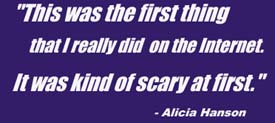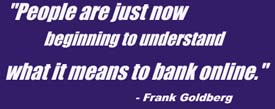|
Banking with a mouse
|
 |
September 13, 1999: 6:31 a.m. ET
For people who are satisfied with a digital link, Internet banking can work
By Staff Writer Alex Frew McMillan
|
NEW YORK (CNNfn) - Alicia Hanson had never bought anything on the Internet when she opened an account with the virtual bank Net.Bank in May 1998. "It was kind of scary at first," she recalled.
Hanson, a 26-year-old who works as a technology consultant in the Atlanta suburb of Norcross, Ga., had $2,000 to set aside for a home. When she scoured the newspaper, Net.Bank had the best rates. "I was attracted to their money market" account, which paid 5.5 percent at the time, she remembered. That was enough.
She kept her offline bank account for six months, while she checked out virtual banking: "When I realized everything was going really well, that's when I closed my account with NationsBank," she said.
Now she does all her banking online. "I've opened up to a lot of things," she said, like shopping on the Web.

Not that virtual banking is perfect. The Net.Bank site was slow at first, but it has improved since an upgrade, she said. She has called the bank only once, to get a replacement check card after her purse was stolen during a vacation in Madrid. She got put on hold but she's used to that, she said. "I remember it taking a while," she recalled. "But I'm pretty loyal. I'm happy with their service, really."
There aren't very many true e-bankers
Hanson is one of a rare breed -- the number of people who use virtual banks is very small. Compared with the 8 million to 9 million people accessing their checking online through their traditional bank, only 50,000 to 75,000 people have accounts with virtual banks, according to Jim Bruene, editor of the industry newsletter Online Banking Report.
And there are only a handful of virtual banks, though many traditional banks offer Internet banking. Many of the biggest virtual-banking participants -- such as WingspanBank.com, a Bank One (ONE) subsidiary; TeleBank, which E*Trade (EGRP) is buying; and Security First Network Bank, which the Royal Bank of Canada bought last year -- are online banks with offline partners.
(For a poll about online banking, click here)
Besides those hybrids, there are also a few banks that are strictly virtual and independent, such as CompuBank and the First Internet Bank of Indiana. NextCard, a virtual credit card company, is waiting for regulatory approval of its e-bank.
To date they've only scratched the surface of the potential market. But if the success of Internet brokers is anything to go by, virtual banking could catch on. That's certainly what the industry hopes.
"People are just now beginning to understand what it means to bank online," said Frank Goldberg, CEO of CompuBank, which has around 2,000 customers but is growing around 10 percent a month.
So what do you get?
Convenience and value are the biggest selling points, Goldberg said, the same dynamics that drive the rest of business on the Internet. "We offer people the ability to do their banking any time, any day, from anywhere in the world, and we offer extraordinary value to our customers as well."
Besides 24-hour access, virtual banks claim they pass the benefit of the lower overhead on to their customers. With Net.Bank, Hanson gets free interest checking and can pay her bills online for free. She also likes the convenience of doing her banking when she wants. She has her paycheck deposited directly and says she never needs a branch.
Virtual banks often offer higher interest rates on checking than their brick-and-mortar counterparts, which average 1.68 percent on an interest-checking account. For instance, Security First has a 6 percent checking account, though that's an introductory offer on accounts with less than $10,000. Still, most e-banks pay at least 4 percent.

Virtual banks also waive many of the fees that have become common with traditional banks. And their biggest selling point is electronic bill paying. Most traditional banks charge $5 to $10 a month for the service, but e-banks typically offer it for free.
It's a good lure. Turnover is high with online banking. But once customers set up electronic bill paying, they are extraordinarily loyal, perhaps because they don't want the hassle of reentering all the information about the merchants they're paying.
One problem with virtual banks is that you have to use a traditional bank's ATM network, normally paying fees to do so. Increasingly, Internet banks will refund part of the cost -- CompuBank, for instance, absorbs $6 in ATM charges per month for each customer. Since most banks charge $1.50 per withdrawal, that covers four withdrawals a month.
More services are likely soon
Bruene expects e-banks to evolve. "There's a lot of niches and ways they could cater to online people better," he said. They might start linking e-mail with the account, he suggested, sending customers a message when their account dips below a certain level perhaps. "Or when someone uses your credit card -- 'Were you in Brazil? Someone just used your card there.' "
WingspanBank.com pools different financial services in one spot, offering checking accounts like a virtual bank and acting as a broker referral service for insurance, mortgages and the like. Once E*Trade completes its Telebank deal, it will likely emulate Wingspan's efforts to create a finance "hub" with multiple financial services.
So who is Internet banking right for? The e-banks aren't exactly going head to head with their traditional counterparts, which are counting on the fact that most remote bankers still want to use a branch every now and then -- or want to know that they can.
"The pure Internet banking companies definitely serve a niche customer segment," said Wendy Grover, a spokeswoman for Wells Fargo. It has more than 1 million Internet customers, which trails only Bank of America.
Still, "there definitely is a niche for these Internet banks," said Matt Lawlor, CEO of Online Resources & Communications Corp., which provides online-banking services for both traditional and virtual banks. While a third of bank customers want to use branches only, a third mix branch banking with "remote" banking by phone and computer, and a third predominantly use just remote banking, he said.
For people who are tech-savvy and happy with the idea of never seeing the inside of another branch, e-banks are a good solution. Gomez Advisors, which rates online brokerages, also tracks online banks. Though it doesn't break out the virtual-only banks, its scorecard rates online bank offerings according to cost, customer service, range of services and so on.
Higher interest, no fees and the ability to manage your finances more conveniently are attractive. Bruene pointed out that virtual banks are likely to be at the forefront with new services. But if your local bank offers a similar competitive service, there's little incentive to switch over, he said. Sometimes all you get is a better deposit rate.
"Right now it's not a no-brainer to go out and say you should bank at an e-bank," Bruene said. Look around, he advised. "It depends on what you need."
|
|
|
|
|
 |

|

